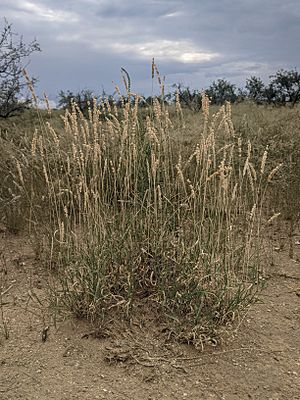Tobosa grass facts for kids
Hilaria mutica, also known as tobosa grass, is a type of grass. It grows naturally in Northern Mexico and the Southwestern United States. You can find it in states like Arizona, New Mexico, Oklahoma, and Texas.
Quick facts for kids Tobosa grass |
|
|---|---|
 |
|
| Conservation status | |
| Scientific classification | |
| Synonyms | |
|
Pleuraphis mutica Buckley |
Contents
What Tobosa Grass Looks Like
Tobosa grass is a perennial grass. This means it lives for more than two years. It grows from underground stems called rhizomes. These rhizomes help the grass spread and form a thick mat on the ground, called sod.
This grass usually grows about 30 to 60 cm (0.98 to 1.97 ft) tall. Sometimes it can reach up to 90 cm (3.0 ft). Its stems start low to the ground and then grow straight up.
Most of its stiff, smooth leaves grow from the base of the plant. They can be up to 15 cm (5.9 in) long. The stems come from a strong, woody root system. These roots can go as deep as 1.8 m (5.9 ft) into the soil.
How Tobosa Grass Reproduces
The plant's flowers grow in a cluster called an inflorescence. This cluster is a few centimeters long and can be white, straw-colored, or purplish. The tiny flowers, called spikelets, grow in groups of three.
Tobosa grass mostly spreads by its underground rhizomes. It does not often make seeds that can grow into new plants. Sometimes, a fungus called ergot can grow on the plant.
Where Tobosa Grass Grows
Hilaria mutica is a very common grass in the semidesert grasslands of its native region. It is a "climax species." This means it is a stable and important plant in areas that often flood and then dry out. It can also grow on higher, drier land.
You can find it in different habitats. These include pinyon-juniper woodlands and areas with mesquite or creosote bushes. It grows best in places that get flooded for a few days and then dry up. But it can also grow in drier soils and can handle some drought.
It often grows in clay soil. You might see it with honey mesquite trees. Other plants that grow near it include burrograss, alkali sacaton, and other types of dropseed grasses. You can also find it with grama grasses, muhly grasses, and tarbush.
How Tobosa Grass Is Used
Tobosa grass is an important food source for cattle and horses in the American Southwest. It grows a lot and tastes good to animals when it is young. As it gets older, it becomes tougher.
This grass is especially helpful during dry times. It stays alive even when other grasses die from lack of water. When it is still green, it can be cut and made into hay to feed animals later.
In Texas, one acre of tobosa grass can produce about 1000 pounds of food. Farmers can get even more with careful management. In places with enough rain, people sometimes burn old grass. This helps new, green stems grow, providing more food for animals.
However, if the grass has the ergot fungus, it can make animals sick if they eat it.
See also
 In Spanish: Toboso para niños
In Spanish: Toboso para niños


